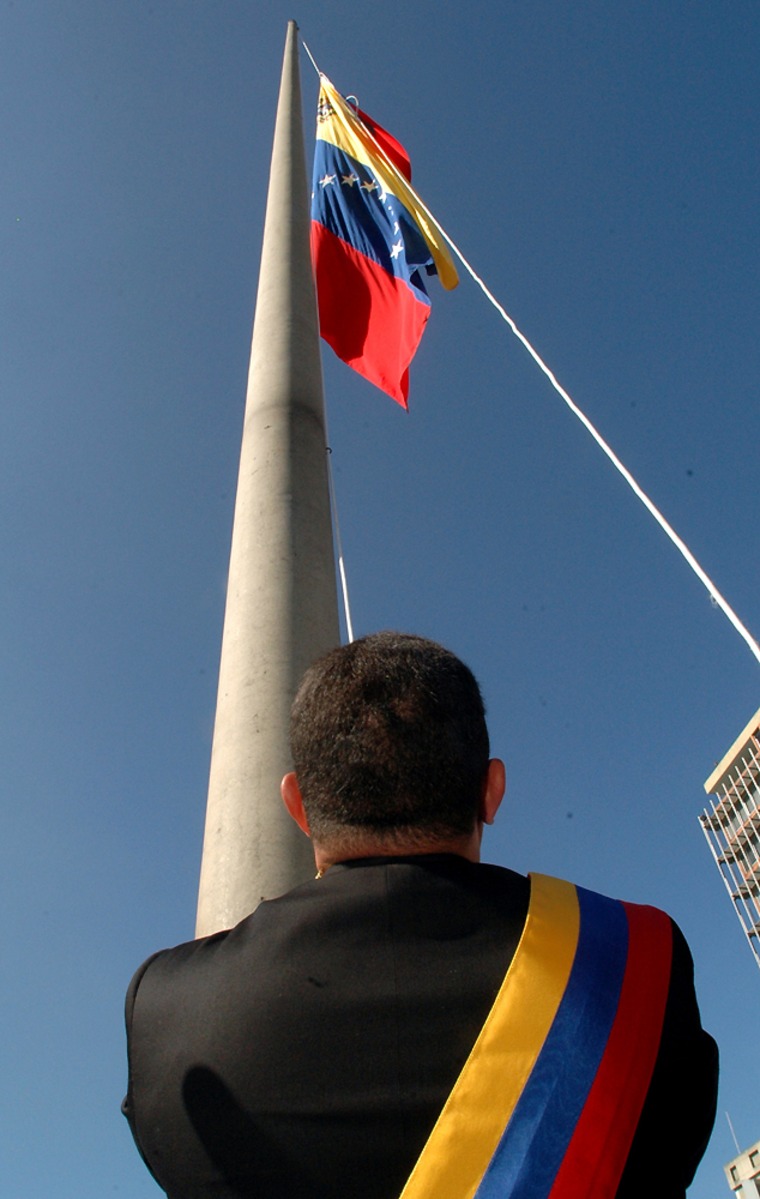Venezuela’s president raised a new national flag Sunday with changes that he said pay tribute to the independence hero Simon Bolivar, drawing criticism from opponents who called it an egotistical political stunt.
The flag proposed by President Hugo Chavez features a white horse galloping left instead of right, an additional star, a bow and arrow representing Venezuela’s indigenous people and a machete to represent the labor of workers, among other changes.
Chavez raised the new flag in a ceremony that was followed by a parade of thousands of soldiers and supporters, while his opponents held a smaller march to protest the new flag and coat of arms.
“The white horse is now liberated, free, vigorous, trotting toward the left, representing the return of Bolivar and his dream,” Chavez said.
The Venezuelan president, who is leading what he calls a “Bolivarian Revolution” to install socialism and help the poor, hoisted the flag, applauded and smiled as soldiers stood at attention during an outdoor ceremony on the 200th anniversary of Venezuela’s tricolor flag.
The new flag and coat of arms will eventually be adopted in the currency, passports and government documents.
Some are opposed
Critics call the changes a waste of money. “It’s a whim of the president,” said Lilian Luces, 54, who marched among nearly 2,000 government opponents. Alicia Castillo, a 50-year-old fellow protester, said Chavez had succeeded in adopting “his own flag.”
When several Chavez supporters hung the new flag from light posts along the protest route, some opposition marchers pulled it down. The two groups struggled over the flag, shouting, until police separated them.
Opposition protesters held the old seven-starred flag, saying it will remain their national symbol.
Many Chavez supporters arrived at the parade in government buses, and formed a sea of red T-shirts and miniature flags. No official crowd estimates were available, but reporters estimated more than 20,000 people attended, including participants and observers.
Some said the opposition appears to be grasping at straws in opposing the flag changes.
“What they’re trying to do is sabotage everything the president does, but they don’t have any support,” said Nelson Rodriguez, 43, who receives a state stipend to help administer neighborhood health programs.
Artistic license or political metaphor?
Venezuela’s solidly pro-Chavez National Assembly approved the new flag and coat of arms last week.
The horse in the coat of arms, which appears in the official flag’s upper left corner, previously galloped right with its neck craning back the other way.
Chavez has said the horse looked unnatural gazing backward, and that historical drawings showed it was supposed to be running “freely to the left.”
Many have suggested the horse’s turnabout is simply a metaphor for Chavez’s politics. He has acknowledged the political symbolism only vaguely, calling the old image an “imperial horse” drawn up by mistaken past leaders.
The government apparently did not have time to update Chavez’s presidential sash, which bore the old coat of arms with the horse galloping to the right.
A talent for tweaking icons
Chavez has displayed a penchant for changing Venezuela’s national symbols since he was first elected in 1998, overseeing the drafting of a new constitution, renaming Congress the National Assembly and renaming the country itself, now the Bolivarian Republic of Venezuela.
The new flag design adds an eighth star to Venezuela’s yellow, blue and red flag, which since 1863 has had seven stars representing the original seven provinces that rose up against colonial Spain.
Chavez suggested the additional star to represent the early 19th-century eastern province of Guayana, which was initially loyal to Spain but then joined an independent Venezuela.
Bolivar once proposed a flag with eight stars in 1817, and it was used for several years. Chavez has called it the “Bolivarian star.”
